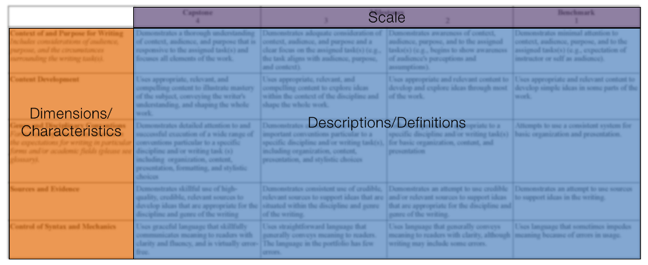What is a rubric?
Broadly defined, a rubric is any tool used to communicate information about expectations for quality. In education, rubrics often manifest as a scoring instrument to assess a student’s mastery or accomplishment of a specific skill, task, or assignment. Students can also consult the rubric when creating their work and providing peer feedback. There are several types of rubrics, including analytic and holistic.
Analytic rubrics consist of a combination of the following three elements:
 Dimensions/characteristics – the relevant factors that an evaluator should consider when determining quality
Dimensions/characteristics – the relevant factors that an evaluator should consider when determining quality
Scale – the distinct levels of quality into which the evaluator assigns each dimension
Descriptions/definitions – the details of the features of performance or accomplishment at a particular level of the scale

Holistic rubrics present all dimensions of quality in paragraph or list format, describing characteristics of proficiency from exemplary to unacceptable (image source Skibba n.d.).
The instructor assigns one composite score instead of a separate score for each dimension.
Why use rubrics?
Rubrics that are shared with students in advance of scoring can support self-directed learning because clear descriptions of expected levels of performance provide specific targets at which students can direct their efforts. Perhaps a result of clear delineations between levels of performance, students also tend to feel that they are graded more fairly when a rubric is used than when there is no rubric or when they are unaware of it in advance. There is also some evidence to suggest that introducing rubrics into a course can lead to higher grades and deeper learning.
To take full advantage of the learning benefits of rubrics, they should be shared or co-created with students well in advance of evaluation period (Reddy & Andrade, 2010). While having its advantages for the students, instructors also benefit from utilizing rubrics because they make the process of grading assignments both easier and faster (Walvoord & Anderson, 1998).
References
Reddy, Y. M., & Andrade, H. (2010). A review of rubric use in higher education. Assessment & evaluation in higher education, 35(4), 435-448.
Skibba, K. (n.d.). Rubrics: Advantages and Best Practices. Retrieved from https://wisc.pb.unizin.org/teachonlinerubrics/chapter/types-of-rubrics.
Anderson, V., & Walvoord, B. (1998). Effective grading: A tool for learning and assessment. San Francisco, 1.
